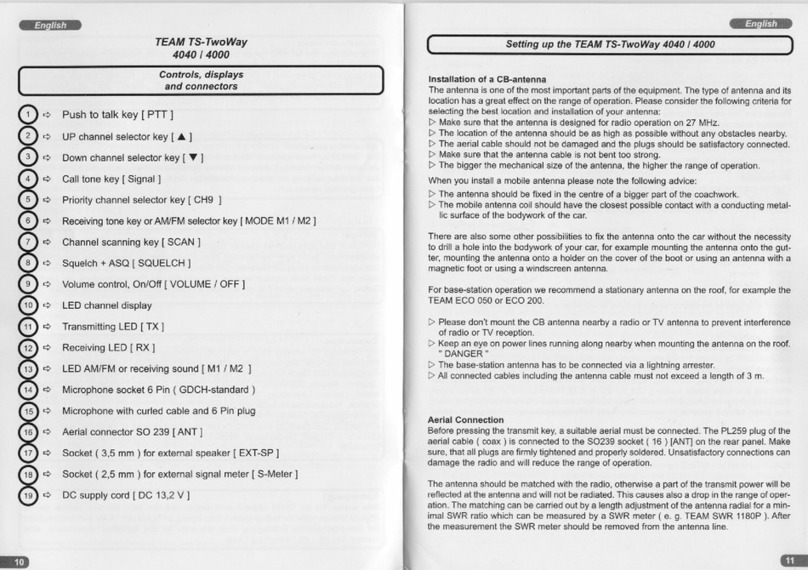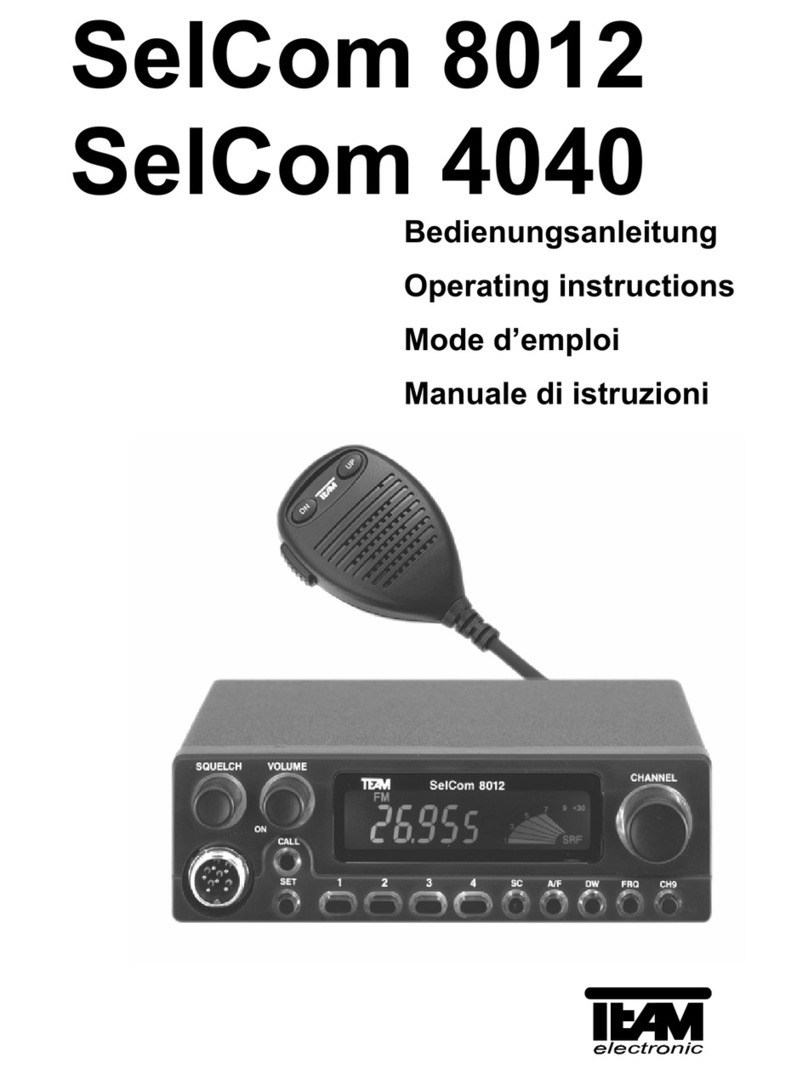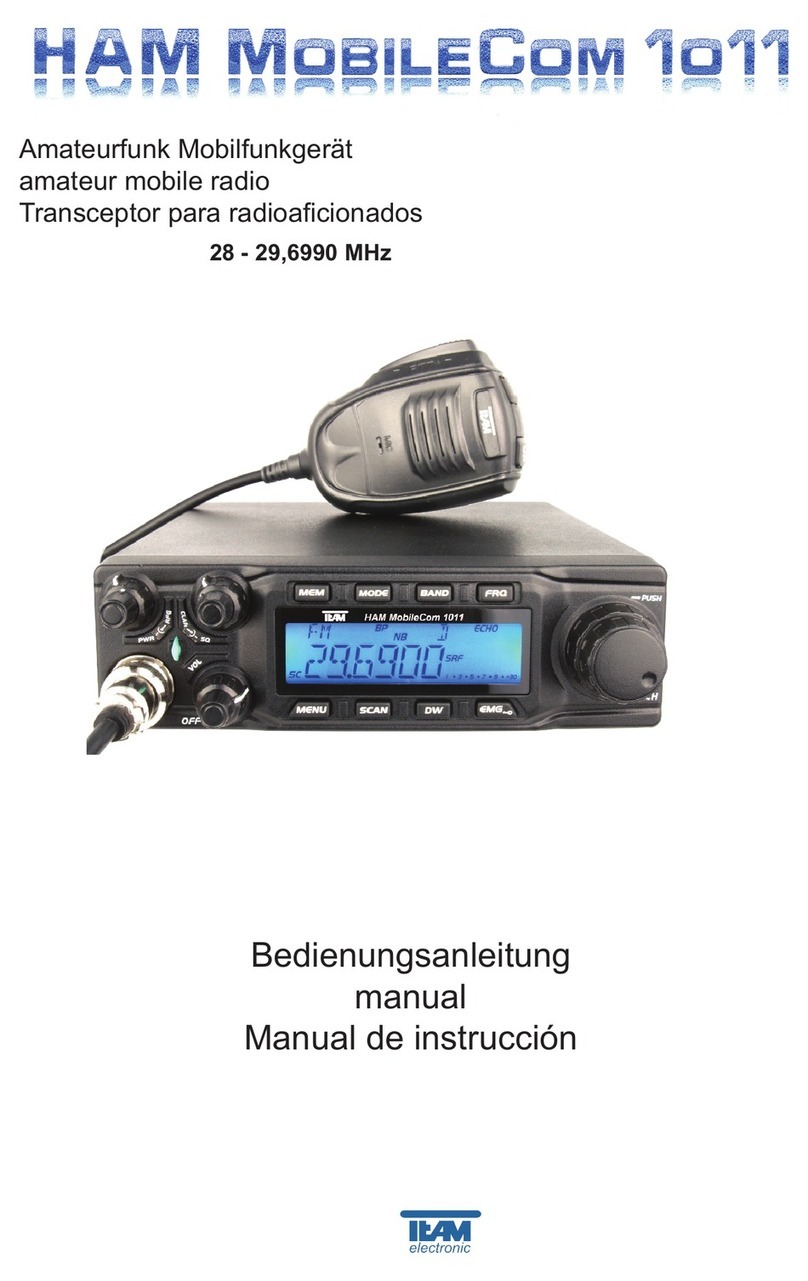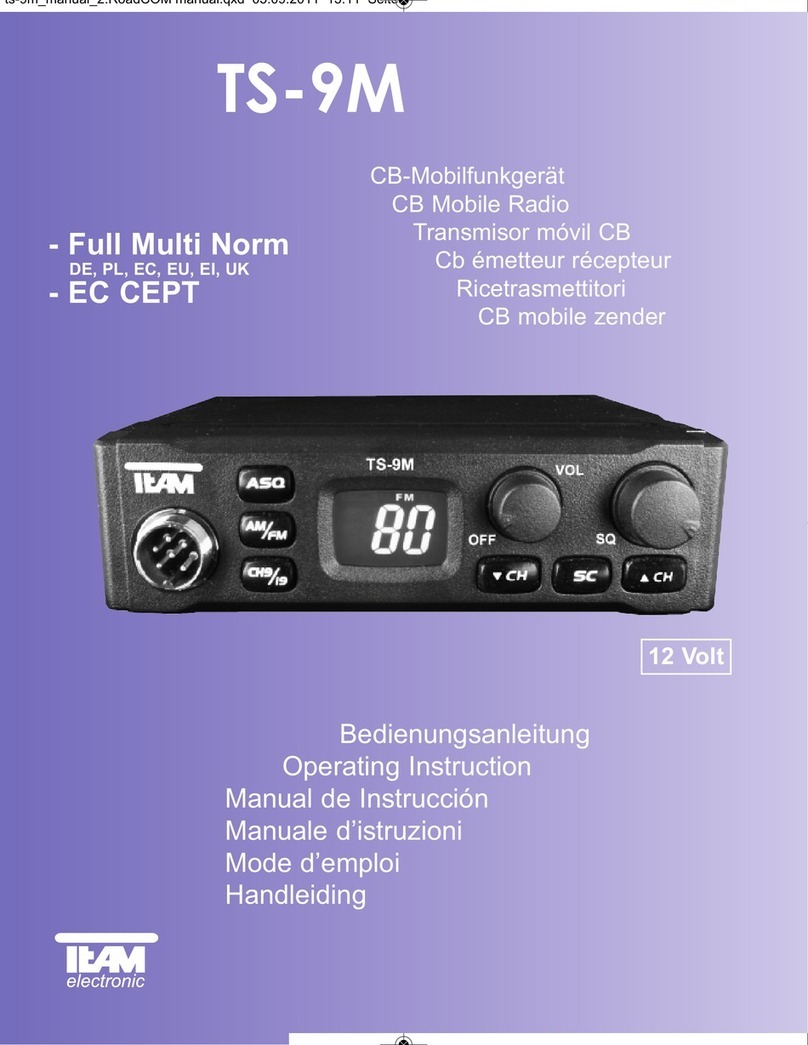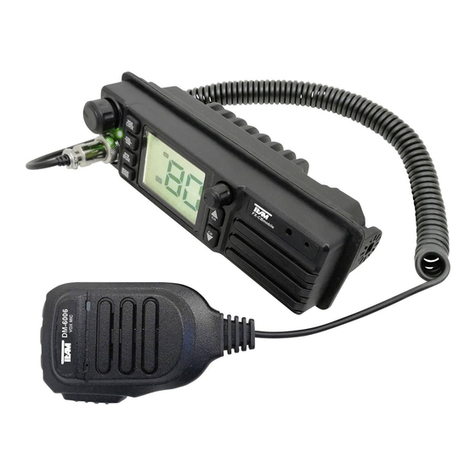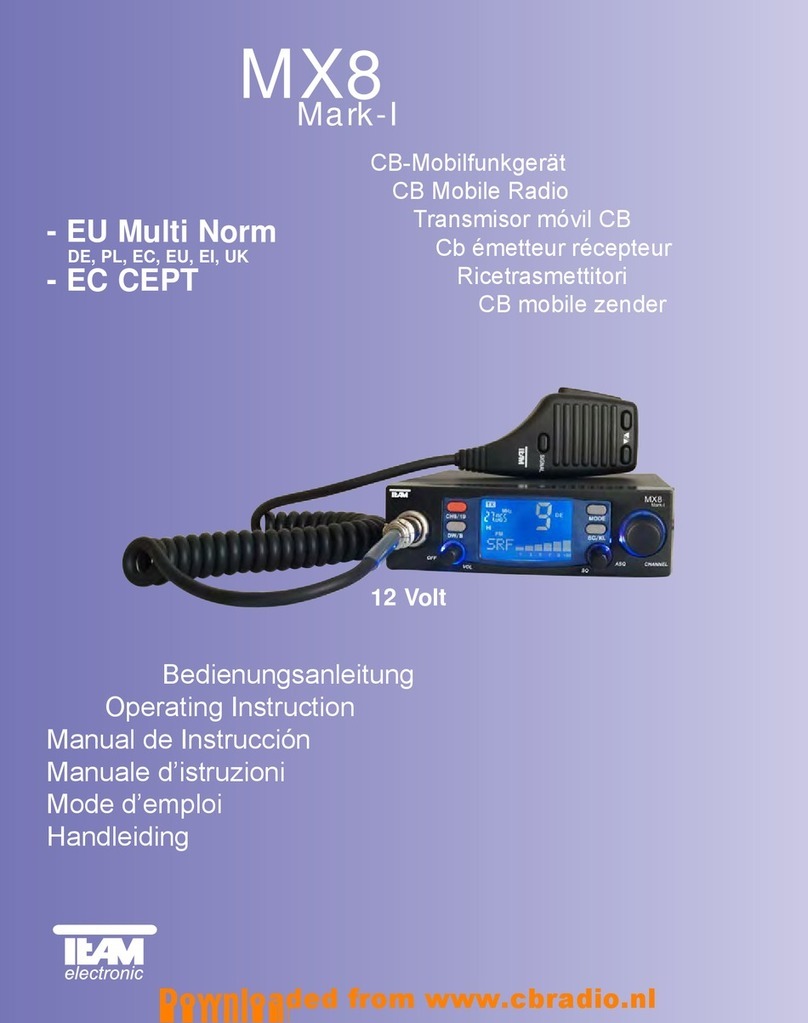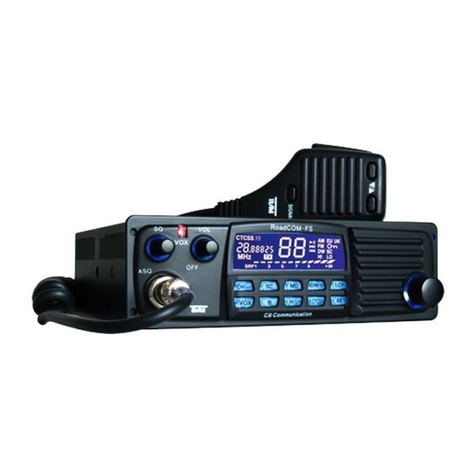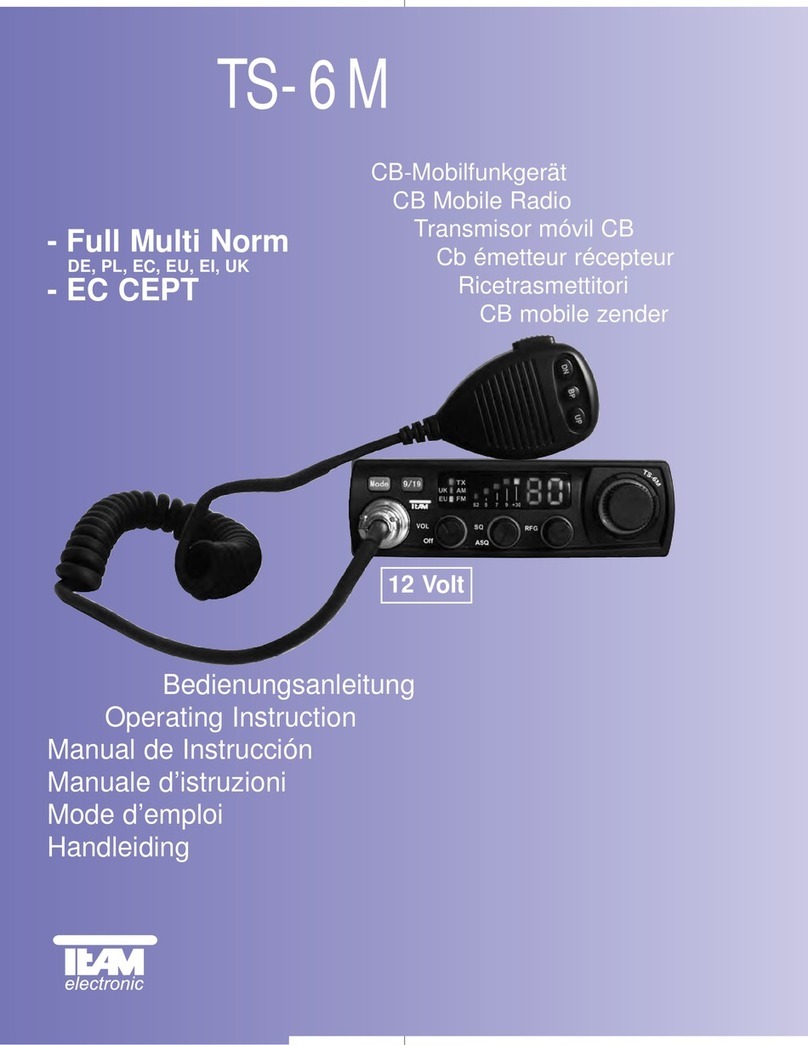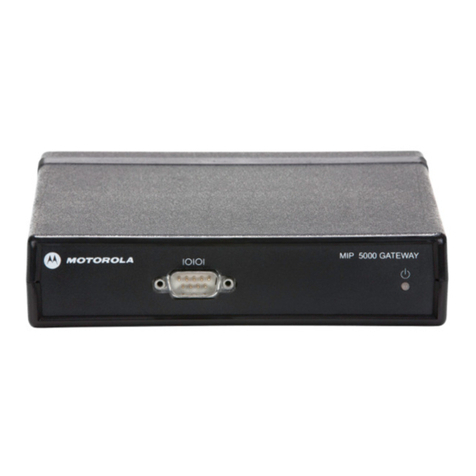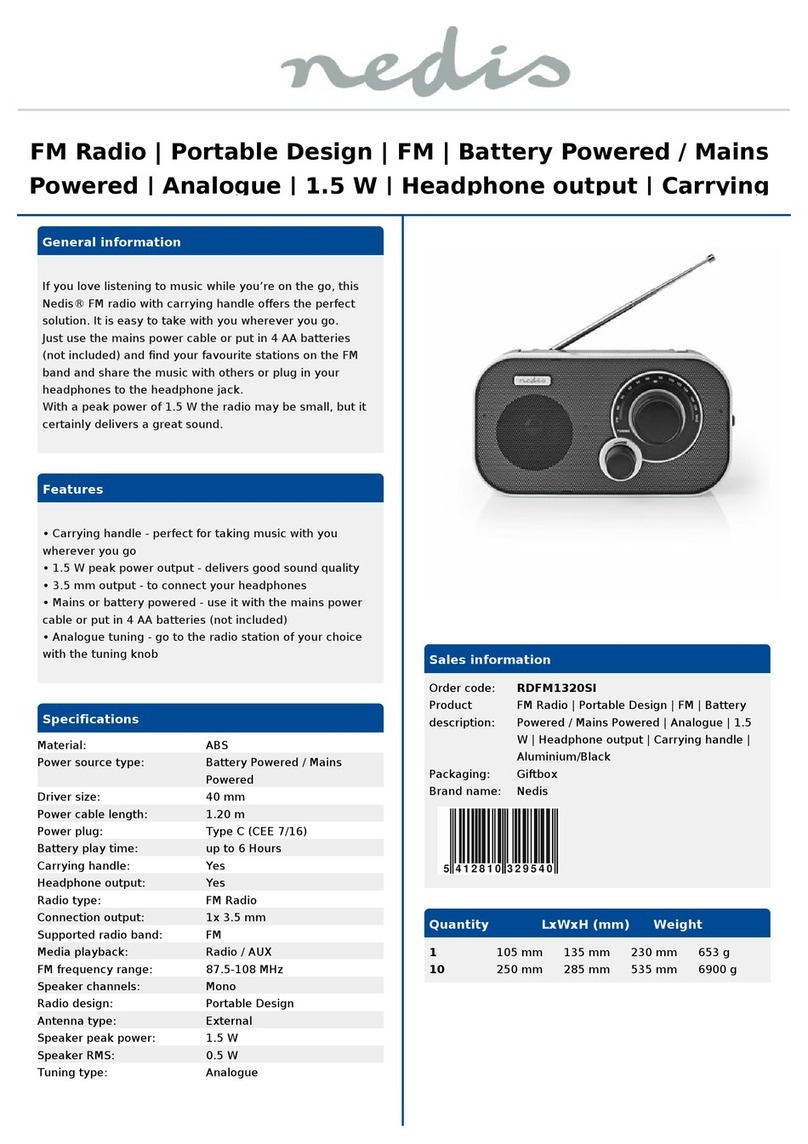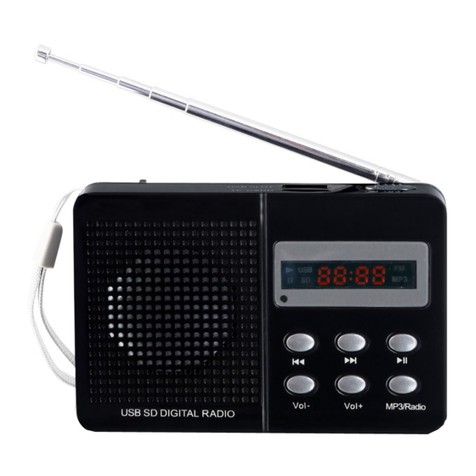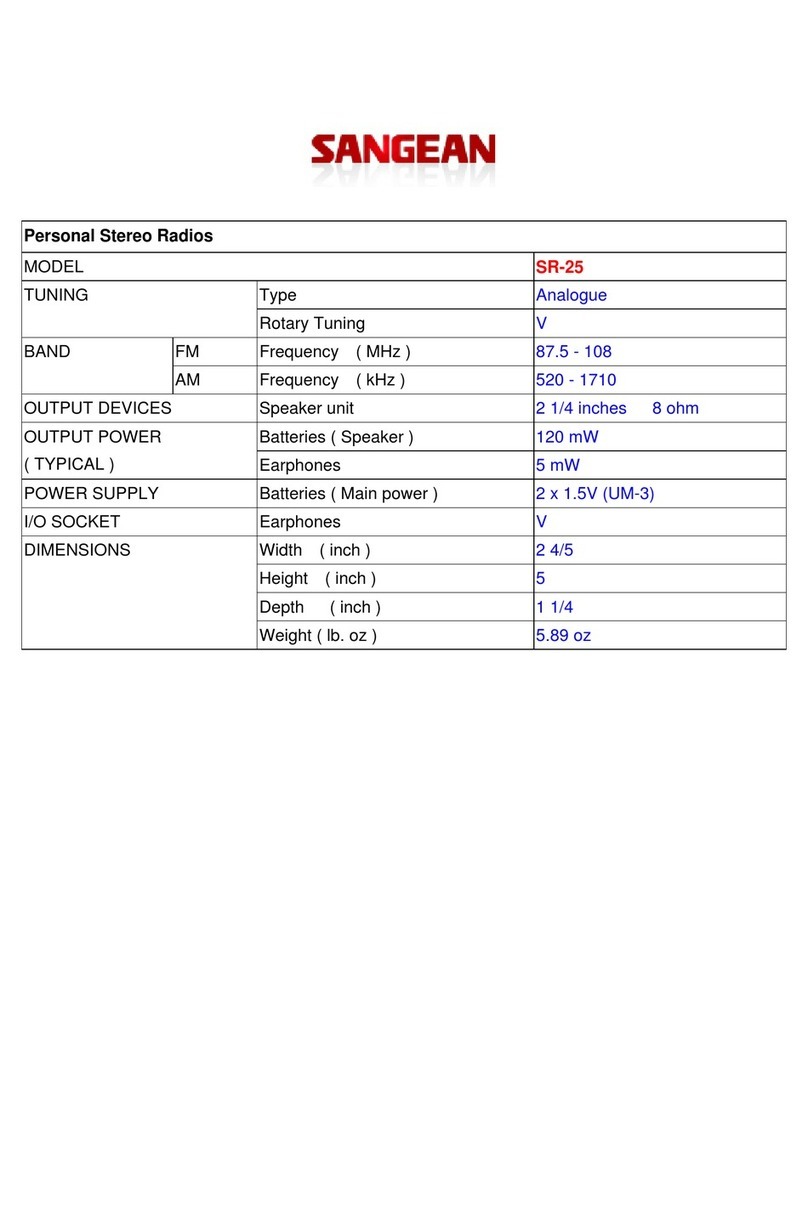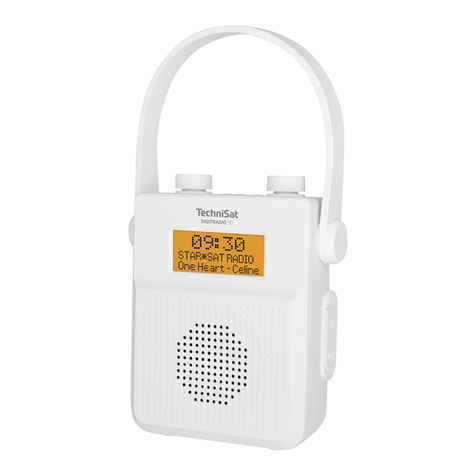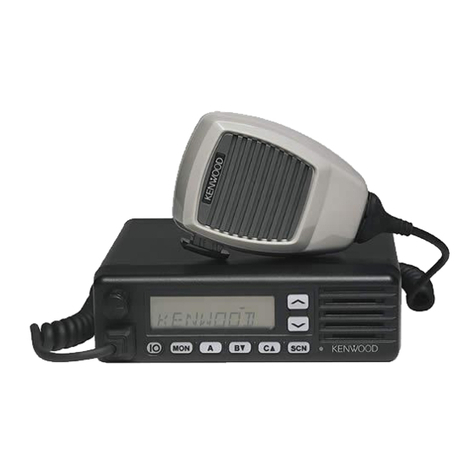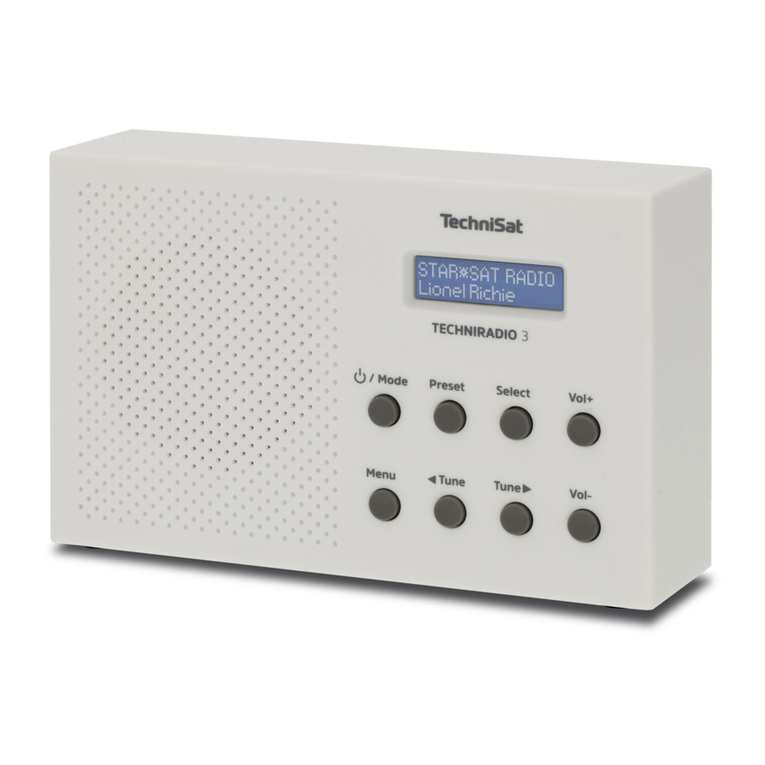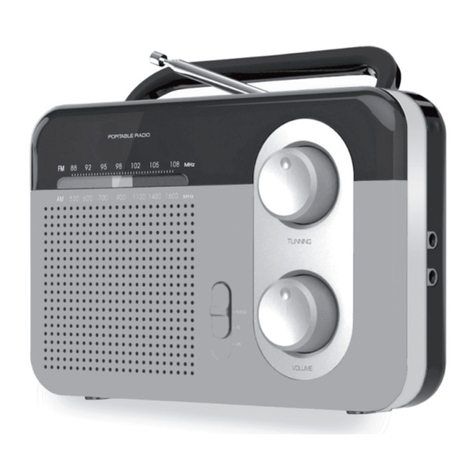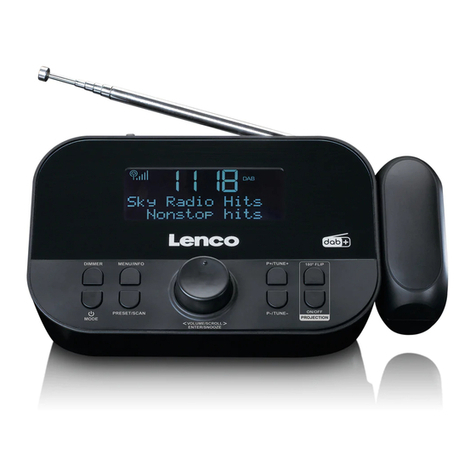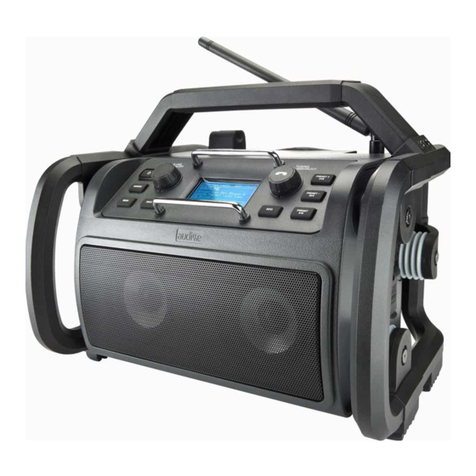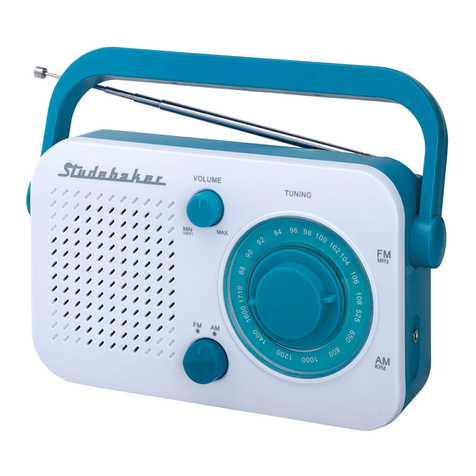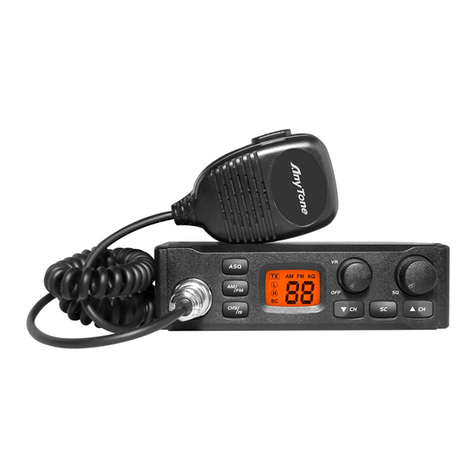Team SelCom 4000 User manual

SelCom 4000
Bedienungsanleitung
Operating instructions
Mode d’emploi
ELECTRONIC

Inhalt, Contents, Contenu Seite, Page, Page
Bedienelemente 3 / 4
Controls 3 / 11
Eléments de commande 3 / 21
Bedienungsanleitung 5 -
10
Operating instructions 12 -
17
Mode d’emploi 22 -
27
Schaltplan / Schematic Diagram /
Schéma de principe ( Main PCB ) 18 -
19
Schaltplan / Schematic Diagram /
Schéma de principe ( Front PCB ) 20
Blockschaltbild / Block Diagram 28
Bestückungspläne und Platinenlayouts /
Components locations and PCB Layouts 29 -
31
Technische Daten / Technical Data /
Caractéristiques 32
Ersatzteile / Spare parts 33 -

TEAM SelCom 4000
CHANNEL
VOLUME
SQUELCH
CALL
SET 1234
ON
SC LCR DW FRQ CH9
SelCom 4000TEAM
1234
5
6
7
8
9
10
11
12
13
14
15
16
ANT DC 13.8V
EXT SP
EXT S-
METER
17 18 19
20
- 3 -

TEAM SelCom 4000
OPERATION CONTROLS, DISPLAYS AND CONNECTORS
( 1 ) Squelch control [ SQUELCH ]
( 2 ) Volume control / ON switch [ VOLUME / ON ]
( 3 ) LCD display window for channel number, frequency, and S-meter
( 4 ) Rotary switch for channel selection UP/ DOWN [ CHANNEL ]
( 5 ) Microphone connector 6 pin for any microphone with or without
UP/DOWN channel selection and amplifier
( 6 ) Call and encoding button for transmitting of the DTMF selective call
[ CALL ]
( 7 ) Standby and encoding button for receiving of the DTMF selective call
[ SET ]
( 8 ) Channel save [ 1 ] and encoding button for DTMF dual tone No. 1.
( 9 ) Channel save [ 2 ] and encoding button for DTMF dual tone No. 2.
( 10 ) Channel save [ 3 ] and encoding button for DTMF dual tone No. 3.
( 11 ) Channel save [ 4 ] and encoding button for DTMF dual tone No. 4.
( 12 ) Button for occupied channel search function SCAN [ SC ]
( 13 ) Button for last channel recall function [ LCR ]
( 14 ) Button for dual watch function [ DW ]
( 15 ) Toggle switch button for channel or frequency display [ FRQ ]
( 16 ) Priority channel selector button [ CH9 ]
( 17 ) Antenna connector SO239 [ ANT ]
( 18 ) Socket for external speaker 3.5 mm [ EXT SP ]
( 19 ) Connector for DC supply cord ( 3 pin ) [ DC 13.8V ]
( 20 ) Socket for external S-meter 2.5 mm [ EXT S-METER ]
- 11 -

SETTING UP THE TEAM SELCOM 4000
1. AERIAL CONNECTION :
The PL259 plug of the aerial cable ( coax ) is connected to the SO239 antenna
socket ( 17 ) ANT on the rear panel. Make sure that the plug is firmly tightened
and properly soldered to the 50 ohm coaxial cable. Unsatisfactory connections
can damage the radio and will reduce the range of operation.
2. MICROPHONE :
Insert the 6 pin plug of the curl cord of the microphone into the microphone con-
nector ( 5 ) on the left side of the front panel. Note it will only go in one way
round. Tighten the plug firmly to secure it. No transmission and receiving of the
SelCom 4000 is possible without the microphone.
3. POWER SOURCE :
Before connecting the power source to the DC connector ( 19 ) the device must
be switched off by turning the volume knob (2)VOLUME / ON counterclockwise
as far as the stop and hearing a switching sound. The fused DC power cable
supplied, is used to make the necessary power connection to the transceiver.
The unit is designed to operate from a battery source of 13.8 volts DC, employ-
ing negative ground electrical system.
BLACK connect to ( - ) MINUS of the car battery / GROUND
RED connect to 12 volts ( + ) PLUS of the car battery. This wire
can be connected to the ignition to prevent the use of the
radio while the ignition is off.
For base-station operation connect the radio to a suitable power supply ( 13.2V / 1.5A ).
OPERATION OF THE TEAM SelCom 4000
After the antenna, the microphone and the power source have been connected,
radio operation can be undertaken.
1. SWITCHING ON [ VOLUME / ON ] :
Switch the radio on by turning the volume control ( 2 ) VOLUME / ON clockwise
and adjust it to a comfortable listening level. If the transceiver is on a clear chan-
nel and not muted by the squelch function a noise should be heard from the
speaker now. The back illumination of the display ( 3 ) and the front panel will
light up. When the unit is switched on the first time or after being disconnected
for a longer period the first channel will be channel 9. The display will show [ 9,
FM and SRF ]. If the power source is not disconnected after switching off the
settings and functions will be stored ( memory backup ). All correct entries will be
confirmed by a receipt tone.
- 12 -

2. [ SQUELCH ] :
Rotate the squelch control ( 1 ) SQUELCH slowly clockwise until the background
noise just disappears while any incoming signal will be heard. The squelch con-
trol should only be turned up enough to stop the background noise on an unused
channel. Turning the control further clockwise will increasingly suppress interfer-
ing signals as well as weak stations. The setting should be made on an unused
channel.
3. CHANNEL SELECTION [ CHANNEL ] :
Select the desired channel 1 - 40 with the channel selector switch ( 4 )
CHANNEL.The display ( 3 ) shows the actual channel. The CH9 function CH9
must not be activated which is indicated by a flashing “9“ in the display. In paral-
lel the channels can be controlled by the built in UP/DOWN buttons of the micro-
phone. The channel numbers step in a ring like system UP from 40 to 1 and
DOWN from 1 to 40 and opposite. It is also possible to show the actual fre-
quency ( in MHz ) in the display instead of the channel numbers by pressing the
button ( 15 ) FRQ. This has no influence on the following described functions. By
pressing the button ( 15 ) FRQ a second time the channel number will appear in
the display again.
Radio operation is only possible with the counter station at coinciding channel
numbers or channel frequencies. By pressing the instant channel key ( 16 ) CH9
channel 9 can be selected for transmit and receive immediately. A flashing “ 9“
will appear in the display. No channel selection is possible now. Pressing CH9
again will cancel this function and the unit returns to the previous selected chan-
nel.
4. LAST CHANNEL RECALL [ LCR ] :
By activating button ( 13 ) LCR the transceiver will tune to that channel where
the last transmission was made. Now the actual channel is stored as the last
channel. Pressing the key ( 13 ) LCR again will make the unit return to the actual
channel.
5. OCCUPIED CHANNEL SEARCH ( SCAN ) [ SC ] :
Before selecting the SCAN function set the squelch control ( 1 ) SQUELCH ac-
cording to Para “2“ because this function does not work with unmuted receiver.
Depress the key ( 12 ) SC now. In the display appears [ SC ] and the channels
are stepping upwards. SCAN stops on the first occupied channel, where a signal
can trigger the squelch threshold. It continues after 10 seconds when the signal
falls below the squelch threshold. Depressing the key ( 12 ) SC again or any
other, except ( 15 ) FRQ, will stop the SCAN function.
- 13 -

6. DUAL WATCH [ DW ] :
This function allows to watch activity on a second channel. Before selecting the
DW function set the squelch control ( 1 ) SQUELCH according to Para “2“. Select
now the first channel which you want to survey and then depress briefly the button
( 14 ) DW. In the display appears a flashing [ DW ] sign. Start within 5 seconds se-
lecting the second channel which you want to survey otherwise the DW function
will stop automatically. After having reached the desired channel press the button
( 14 ) DW another time and [ DW ] will appear permanently. Now the DW function
is completely activated. The DW function will remain on this channel if the incom-
ing signal can open the squelch and is not longer interrupted than 10 seconds.
Otherwise the unit will tune to the other channel. If no signal is found there the ra-
dio will step every second to the other channel. Depressing the key ( 14 ) DW
again or any other, except ( 15 ) FRQ, will stop the DW function.
7. TRANSMIT ( PUSH TO TALK / PTT ) :
To transmit depress and hold the PTT key on the microphone. In the display ap-
pears [ TX ] and together with the symbol [ SRF ] = ( Signal Radio Frequency )
the relative output power will be shown in form of a progressively increasing
number of bar sections. The microphone sensitivity has been set to give good
results speaking normally at a distance of 2 - 4 inches. Speaking too loudly will
cause distortion and make the signal difficult to understand especially in case of
amplifier or echo microphones. While the set is in the transmitting mode there is
no key entry possible and the receiver is muted. On completion of the transmis-
sion release the PTT key and the set will revert to receiving mode.
8. S-METER [ EXT S-METER ] :
Behind the letters [ SRF ] the relative transmit power and received fieldstrength
will be displayed in the window ( 3 ), forming progressive bar sections. The
SelCom 4000 has on its rear panel a socket ( 20 ) EXT S-METER for the con-
nection of an additional S-meter with a 2.5 mm plug.
9. EXTERNAL SPEAKER [ EXT SP ] :
The TEAM SelCom 4000 has on its rear panel a socket ( 18 ) EXT SP for an
external speaker of 4 - 8 ohm impedance with 3.5 mm plug. At 4 ohms the dissi-
pation of the speaker can be up to 2 watts.
10.KEYS [ 1 - 4 ] FOR CHANNEL MEMORY :
The TEAM SelCom 4000 can store up to 4 frequently used channels. The de-
fault settings of the memory keys ( 8 - 11 ) 1 - 4 are the channels 1, 9, 19, 40.
These memories can be overwritten with other channel numbers. In case of
data loss the default settings will be stored in the memories again. To save a
- 14 -

new channel first select it with the channel selector switch ( 4 ) CHANNEL. Then
depress a memory key for 4 or 5 seconds until a second receipt tone indicates
the overwriting of the new channel number into the corresponding memory. To
call a saved channel depress briefly the corresponding memory key. On the left
side of the display the actual memory number is displayed in case of data stor-
age or recall. The memory number disappears by selecting a new channel.
11. DTMF SELECTIVE CALL SYSTEM [ CALL / SET ] :
General :
The DTMF selective call system ( = Dual Tone Modulation Frequency ) enables
the radio operator to open one or more muted receiver by transmitting a specially
coded tone sequence. This is only possible on condition that all partners use the
same channel, modulation mode and selective call system. The transceivers
must be switched on and operate normally and the selective call system has to
be set into standby mode to receive the coded tone calls. This will mute the re-
ceiver ( loudspeaker ) until the detection of a coded tone sequence, which corre-
sponds with the own reception code of the transceiver. This will open the re-
ceiver and it will remain unmuted even when the calling station stops transmit-
ting. So all activities on this channel can be heard, and those stations which are
not equipped with a selective call system, too. It is also possible to communicate
with them. They are only unable to open a receiver muted by a selective call sys-
tem.
The TEAM SelCom 4000 selective call system uses 4 dual tones in succession.
There are 4 different dual tones. So there are 256 combinations possible. The
reception code and the transmission code can be programmed separately from
each other. For individual call it is recommended for each participant to program
his own reception code. Example : 4 Partners, consisting of head office and 3
mobile stations: Head office = 1111 / Jack mobile = 1112 / Susan mobile = 1113
/ John mobile = 1114. In case of group call all members have the same reception
code. This will unmute all receivers if the transmitted code is sent out interfer-
ence-free and free of noise. In all cases the transmission code of the calling sta-
tion and the reception code of the listening station have to match. In our example
the head office has to change its transmission code to reach every participant in
case of individual call. The same applies to the mobile stations if they want to
reach each other. If the communication is made with the help of the head office all
mobile stations need only the transmission code 1111.
Entry of the reception code :
Depress briefly the button ( 7 ) SET so that the symbol “music note“ appears in
the display on the top right of the channel number. The receiver is now muted.
Depress the key ( 7 ) SET again but hold it for 3 or 4 seconds until a second
- 15 -

receipt tone indicates that the radio is ready for data input. The display shows
now 0000 with a flashing first digit. Begin now entering within 3 - 4 seconds
the reception code with the keys ( 8 - 11 ) 1 - 4. With every new entry the flash-
ing digit moves one step further to the right. After entering the last digit the inputs
will be saved 3 - 4 seconds later automatically and the display will revert to the
normal mode. The same procedure applies when you overwrite previous entries.
Entry of the transmission code :
Depress briefly the button ( 7 ) SET so that the symbol “music note“ appears in
the display. Then depress the key ( 6 ) CALL and hold it for 3 or 4 seconds until
a second receipt tone indicates the readiness for data input. The display shows
again 0000 with a flashing first digit. Begin now entering within 3 - 4 seconds
the transmission code with the keys ( 8 - 11 ) 1 - 4. With every new entry the
flashing digit moves one step further to the right. After entering the last digit the
inputs will be saved 3 - 4 seconds later automatically and the display will revert to
the normal mode. The same procedure applies when you overwrite previous entries.
Radio operation with the DTMF selective call system :
To activate the DTMF selective call system depress briefly the button ( 7 ) SET so
that the symbol “music note“ appears in the display. This will mute the receiver and
make it ready to decode received selective tone calls on the actual channel. In case of a
previous sent out transmission code or recognition of a selective tone call the receiver
will be opened. The symbol “music note“ will remain in the display instead. If you want to
make it silent again you have to cancel the DTMF function ( “music note“ disappears )
and to reactivate it again by pressing the button ( 7 ) SET two times.
A transmission of a selective tone call is only possible with the activated DTMF function (
symbol “music note“ ) in the display. To start the transmission depress the button ( 6 )
CALL briefly. The radio will switch over to transmission mode and starts sending out the
transmission code. When the tone sequence is sent out completely it will revert to not
muted receiving mode. If the channel is clear and the counter station within the range its
receiver will be opened, too. The communication can begin now.
12. BATTERY BACKUP :
As long as the TEAM SelCom 4000 is connected without any interruption to a car bat-
tery or a switched on power supply the memory contents of selective call codes and
channels will be kept stored, even when it is switched off at ( 2 ) VOLUME / ON. In ad-
dition it contains an built in rechargeable button cell which will only be charged when the
unit is in operation. According to the periods of running and the periods of not working
the charging condition may be quite different. So it is recommended to keep an eye on a
reasonable charging time before writing to the memories. A completely charged battery
can keep the memory contents stored for up to 100 hours even when the unit is discon-
nected from every power source.
- 16 -

13. SERVICING THE TEAM SELCOM 4000 :
There are no user adjustable or user serviceable parts inside the radio. The casing must
not be opened. Independent repairs or adjustments must not be carried out, since each
modification or unauthorised intervention will immediately cancel all and any guarantee
or repair claims, they are also likely to result in nonconformity to approval regulations
which will render the set illegal. In the event of a defect becoming apparent, contact a
properly equipped and authorised dealer.
14. APPROVAL OF THE TEAM SELCOM 4000 :
The transceiver is approved according to ETS 300 135. In most of the member coun-
tries of the European Union the CEPT / ETS approval will be recognised. Therefore it is
free of fees and notice to PTT authorities. Please check your local requirements.
- 17 -

TEAM SelCom 4000
TECHNISCHE DATEN / TECHNICAL DATAS / CARACTERISTIQUES
Allgemein / General / Général
Kanal / Channel /
Canaux
Frequenz / Frequency /
Fréquence
Kanal / Channel /
Canaux
Frequenz / Frequency /
Fréquence
1 FM 26.965 MHz 21 FM 27.215 MHz
2 FM 26.975 MHz 22 FM 27.225 MHz
3 FM 26.985 MHz 23 FM 27.255 MHz
4 FM 27.005 MHz 24 FM 27.235 MHz
5 FM 27.015 MHz 25 FM 27.245 MHz
6 FM 27.025 MHz 26 FM 27.265 MHz
7 FM 27.035 MHz 27 FM 27.275 MHz
8 FM 27.055 MHz 28 FM 27.285 MHz
9 FM 27.065 MHz 29 FM 27.295 MHz
10 FM 27.075 MHz 30 FM 27.305 MHz
11 FM 27.085 MHz 31 FM 27.315 MHz
12 FM 27.105 MHz 32 FM 27.325 MHz
13 FM 27.115 MHz 33 FM 27.335 MHz
14 FM 27.125 MHz 34 FM 27.345 MHz
15 FM 27.135 MHz 35 FM 27.355 MHz
16 FM 27.155 MHz 36 FM 27.365 MHz
17 FM 27.165 MHz 37 FM 27.375 MHz
18 FM 27.175 MHz 38 FM 27.385 MHz
19 FM 27.185 MHz 39 FM 27.395 MHz
20 FM 27.205 MHz 40 FM 27.405 MHz
Betriebsspannung / Power Supply /
Alimentation 13.2 Volt nominal
Stromaufnahme / Power Consumption /
Consommation courant
RX = 490 mA (inklusive Nachtlicht)
TX = 1350 mA
Gewicht, Weight, Poids ca. 750 gr. ohne Zubehör und Verpackung
Maße, Dimensions, Dimension B158, T135, H48 mm ( Gehäuse / Cabinet )
RX - Empfänger / Receiver / Récepteur
Empfindlichkeit / Sensitivity / Sensibilité FM = 0.9 µV / 1.2KHz Dev.. 20 dB (S+N+D)/N
Zwischenfrequenz / Intermediate Frequency /
Moyenne fréquence
1. ZF 10.695 MHz
2. ZF 455 KHz
Selektivität / Adjacent Channel Rejection /
Sélectivité => 60 dB / ETS 300 135
NF-Ausgangsleistung / Audio Output /
Sortie audio 1.0 Watt / 8 Ohm ( 10% THD )
TX - Sender / Transmitter / Emetteur
Sendeleistutng / RF output power /
Puissance de sortie 4 Watt / 50 Ohm
Modulationshub / Deviation / Déviation 2.0 KHz max. ( begrenzt )
Betriebsart / Emission Mode / Emission F3E (FM)
Oberwellen- Nebenwellenunterdrückung /
Harmonic Spurious Rejection /
Réjection des harmoniques
<= 2,5 x 10 -7 W
Table of contents
Other Team Radio manuals
